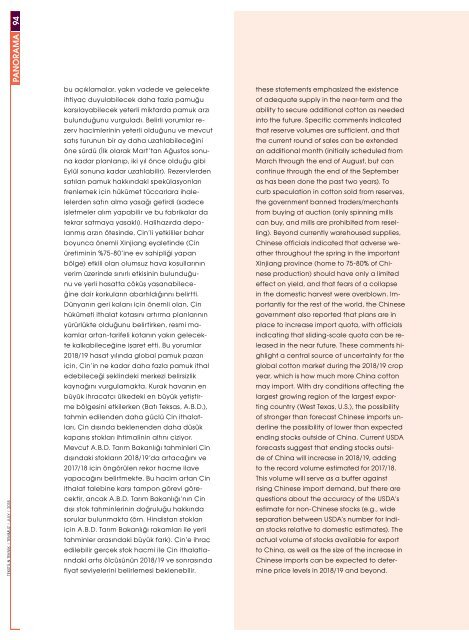You also want an ePaper? Increase the reach of your titles
YUMPU automatically turns print PDFs into web optimized ePapers that Google loves.
94<br />
TEKSTİL & TEKNİK | TEMMUZ | JULY | 2018<br />
PANORAMA<br />
bu açıklamalar, yakın vadede ve gelecekte<br />
ihtiyaç duyulabilecek daha fazla pamuğu<br />
karşılayabilecek yeterli miktarda pamuk arzı<br />
bulunduğunu vurguladı. Belirli yorumlar rezerv<br />
hacimlerinin yeterli olduğunu ve mevcut<br />
satış turunun bir ay daha uzatılabileceğini<br />
öne sürdü (İlk olarak Mart’tan Ağustos sonuna<br />
kadar planlanıp, iki yıl önce olduğu gibi<br />
Eylül sonuna kadar uzatılabilir). Rezervlerden<br />
satılan pamuk hakkındaki spekülasyonları<br />
frenlemek için hükümet tüccarlara ihalelelerden<br />
satın alma yasağı getirdi (sadece<br />
işletmeler alım yapabilir ve bu fabrikalar da<br />
tekrar satmaya yasaklı). Halihazırda depolanmış<br />
arzın ötesinde, Çin’li yetkililer bahar<br />
boyunca önemli Xinjiang eyaletinde (Çin<br />
üretiminin %75-80’ine ev sahipliği yapan<br />
bölge) etkili olan olumsuz hava koşullarının<br />
verim üzerinde sınırlı etkisinin bulunduğunu<br />
ve yerli hasatta çöküş yaşanabileceğine<br />
dair korkuların abartıldığınnı belirtti.<br />
Dünyanın geri kalanı için önemli olan, Çin<br />
hükümeti ithalat kotasını artırma planlarının<br />
yürürlükte olduğunu belirtirken, resmi makamlar<br />
artan-tarifeli kotanın yakın gelecekte<br />
kalkabileceğine işaret etti. Bu yorumlar<br />
2018/19 hasat yılında global pamuk pazarı<br />
için, Çin’in ne kadar daha fazla pamuk ithal<br />
edebileceği şeklindeki merkezi belirsizlik<br />
kaynağını vurgulamakta. Kurak havanın en<br />
büyük ihracatçı ülkedeki en büyük yetiştirme<br />
bölgesini etkilerken (Batı Teksas, A.B.D.),<br />
tahmin edilenden daha güçlü Çin ithalatları,<br />
Çin dışında beklenenden daha düşük<br />
kapanış stokları ihtimalinin altını çiziyor.<br />
Mevcut A.B.D. Tarım Bakanlığı tahminleri Çin<br />
dışındaki stokların 2018/19’da artacağını ve<br />
2017/18 için öngörülen rekor hacme ilave<br />
yapacağını belirtmekte. Bu hacim artan Çin<br />
ithalat talebine karşı tampon görevi görecektir,<br />
ancak A.B.D. Tarım Bakanlığı’nın Çin<br />
dışı stok tahminlerinin doğruluğu hakkında<br />
sorular bulunmakta (örn. Hindistan stokları<br />
için A.B.D. Tarım Bakanlığı rakamları ile yerli<br />
tahminler arasındaki büyük fark). Çin’e ihraç<br />
edilebilir gerçek stok hacmi ile Çin ithalatlarındaki<br />
artış ölçüsünün 2018/19 ve sonrasında<br />
fiyat seviyelerini belirlemesi beklenebilir.<br />
these statements emphasized the existence<br />
of adequate supply in the near-term and the<br />
ability to secure additional cotton as needed<br />
into the future. Specific comments indicated<br />
that reserve volumes are sufficient, and that<br />
the current round of sales can be extended<br />
an additional month (initially scheduled from<br />
March through the end of August, but can<br />
continue through the end of the September<br />
as has been done the past two years). To<br />
curb speculation in cotton sold from reserves,<br />
the government banned traders/merchants<br />
from buying at auction (only spinning mills<br />
can buy, and mills are prohibited from reselling).<br />
Beyond currently warehoused supplies,<br />
Chinese officials indicated that adverse weather<br />
throughout the spring in the important<br />
Xinjiang province (home to 75-80% of Chinese<br />
production) should have only a limited<br />
effect on yield, and that fears of a collapse<br />
in the domestic harvest were overblown. Importantly<br />
for the rest of the world, the Chinese<br />
government also reported that plans are in<br />
place to increase import quota, with officials<br />
indicating that sliding-scale quota can be released<br />
in the near future. These comments highlight<br />
a central source of uncertainty for the<br />
global cotton market during the 2018/19 crop<br />
year, which is how much more China cotton<br />
may import. With dry conditions affecting the<br />
largest growing region of the largest exporting<br />
country (West Texas, U.S.), the possibility<br />
of stronger than forecast Chinese imports underline<br />
the possibility of lower than expected<br />
ending stocks outside of China. Current USDA<br />
forecasts suggest that ending stocks outside<br />
of China will increase in 2018/19, adding<br />
to the record volume estimated for 2017/18.<br />
This volume will serve as a buffer against<br />
rising Chinese import demand, but there are<br />
questions about the accuracy of the USDA’s<br />
estimate for non-Chinese stocks (e.g., wide<br />
separation between USDA’s number for Indian<br />
stocks relative to domestic estimates). The<br />
actual volume of stocks available for export<br />
to China, as well as the size of the increase in<br />
Chinese imports can be expected to determine<br />
price levels in 2018/19 and beyond.

















